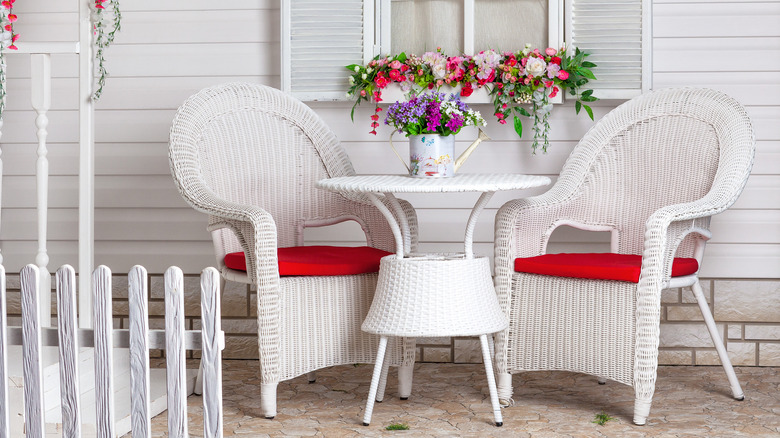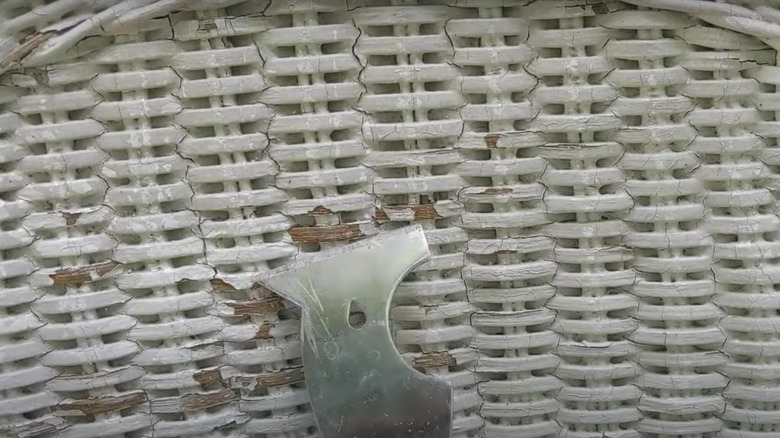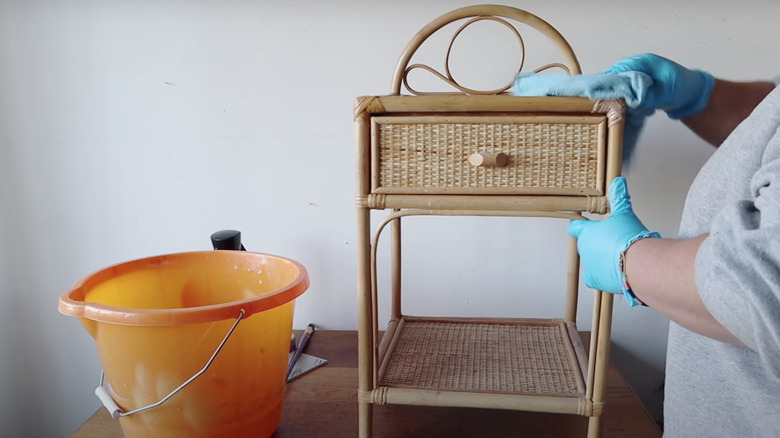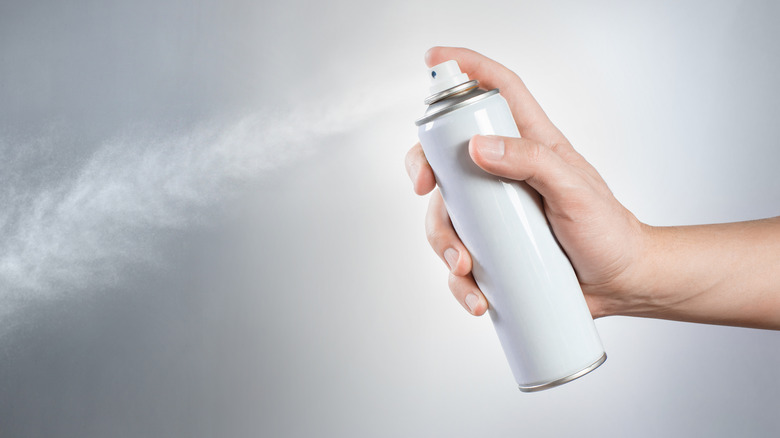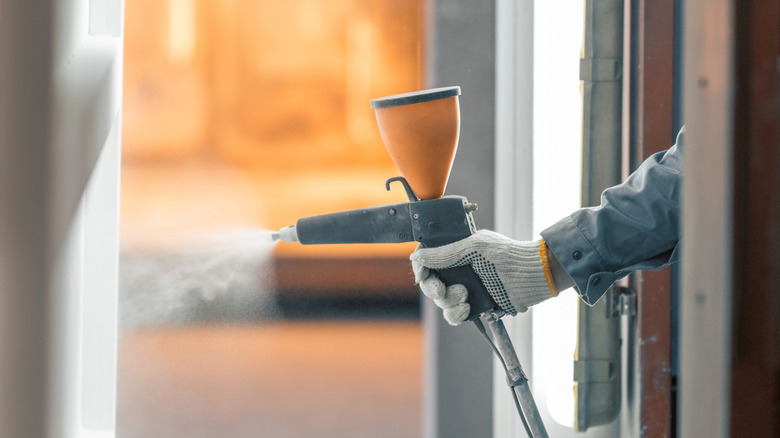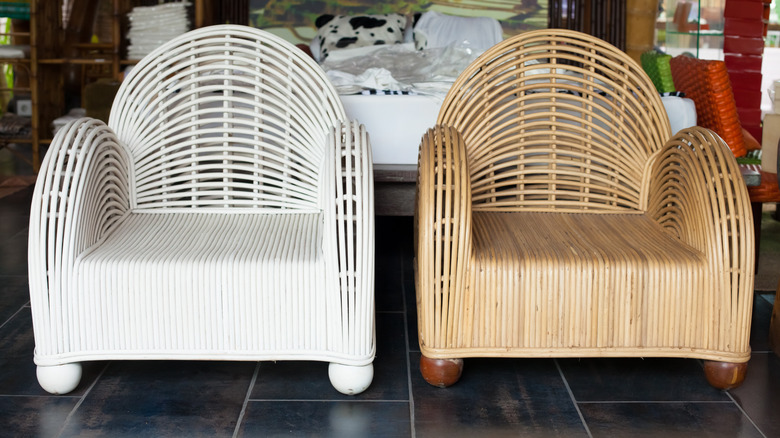How To Repaint Your Wicker Furniture And Bring It Back To Life
While some believe that wicker belongs in the past, others adore of these unique furniture pieces. Wicker items can add natural elements and lots of personality to a space. They are typically used in bohemian-looking rooms, however, Aosom says that wicker can add warmth to just about any styled home. Wicker doesn't require much maintenance or cleaning. Additionally, it's very durable, even in harsh weather. This means that these pieces can work in both indoor and outdoor spaces.
However, while well-maintained wicker can look timeless, older pieces may look run-down. Over time, old painted wicker furniture can begin to peel or chip, taking away from the overall appearance. Repainting a wicker piece will give it new life, which will brighten and modernize any living space. Typically, wicker is painted white, but it could also be painted a darker color, to create a bolder look. Or, you could paint a piece a light brown shade, to give it a faux natural appearance. If you're looking to repaint a wicker piece, here are the steps you'll need to follow.
Remove the old paint
The first step is to remove any old paint — be sure to put on gloves and protective eyewear first. The Wicker Woman says to remove any paint flakes or chips with a wire brush. For paint that doesn't want to come off, you could try using a paint scraper, but be careful not to damage the furniture.
According to DIY Quickly, sand down the surfaces with sandpaper, then wipe away any dust with a wet rag. Then, combine three parts paint remover with one part mineral spirits in a plastic container. Apply this to the furniture and work it into the surface with a scouring pad or stiff brush, and allow to soak for 10 minutes. You'll then need to remove the paint with a foam pad. Wipe down the furniture with paper towels and mineral spirits and sand any rough surfaces again if necessary.
Clean
After removing all the paint that you can, you'll need to clean the furniture thoroughly. Different types of wicker require different cleaning methods. For instance, only synthetic pieces can be washed with water, warns Wicker Warehouse. Natural rattan pieces will absorb moisture, which may undermine their integrity.
If the piece can get wet, you can scrub the surface with a mixture of dish soap and warm water on a small brush — when cleaning with a soapy mixture, ensure all the soap is removed before continuing with the painting process. This may take a few rinses. For stubborn stains, you could spray on a mixture of water and detergent bleach. Allow it to dry completely before moving on to the next step. For natural rattan and wicker, H2O Bungalow suggests using a vacuum with a brush attachment to remove debris from small areas of your furniture piece. Alternatively, Wicker Living recommends sweeping your furniture to clean it, which will also quickly remove any dust and debris.
Prime
The next step is to prime. You will need to tape and cover any areas that you don't want to be painted, like an attached seat cushion. Also, make sure that you complete this step outside on a day that's not very windy. Primer can be applied with a brush or a spray can. The Wicker Woman says that primer is necessary to achieve the paint color you truly desire. The primer should be specifically made for wooden materials and should be oil-based. When priming your piece, remember to use protective gear.
Love Your Abode suggests using at least two coats of spray paint primer to ensure even coverage. You'll need to wait for each coat to dry before applying another, and drying will take up to an hour. Using spray paint will give you a more even look than painting with a brush — however, spray paint is generally more expensive.
Paint
After priming, you're finally ready to paint. H2O Bungalow lists the three possible ways to paint a wicker piece. Wicker could be painted with a natural bristle paintbrush. However, this will take the longest, as it's hard to get into every small crevice of the furniture. You could also use spray paint, but it is expensive and doesn't provide a very high-quality finish. The overall best choice is to use a paint sprayer because it will give the smoothest appearance in the shortest amount of time.
You'll also need to choose the correct paint for the job. Choose a paint that is self-sealing and doesn't require a clear or waxy surface layer to be applied over the top. The Wicker Woman recommends using oil-based paint designed for both inside and outside the home. Avoid latex-based paints, as these will most likely begin to flake after just a few years.
Allow to cure
Finally, you'll need to give your piece time to cure. You may be able to touch your piece and not have any paint transfer pretty soon after painting. However, the paint doesn't fully harden for quite a while. It will take three to four weeks for it to fully cure, explains Salvaged Inspirations. When a piece is cured, that means that the paint has completely bonded to the surface, which will keep it from getting damaged.
Allowing your piece to fully cure is very important, notes Infra Tech. If your piece is moved or used before it's ready, the paint can easily get scratched, scuffed, or could begin to peel. Waiting to use your piece will also prolong its life and the new paint job you just applied. You'll need to allow your wicker furniture to cure in a safe and dry place before using it daily.
